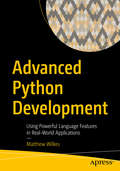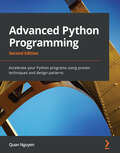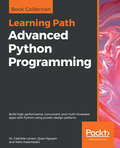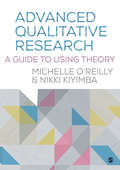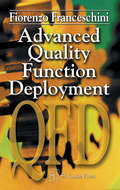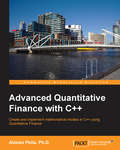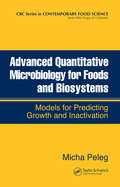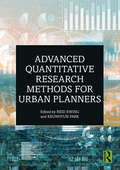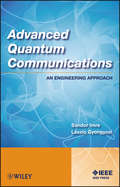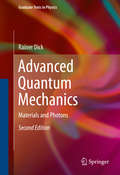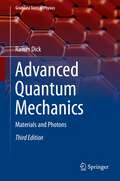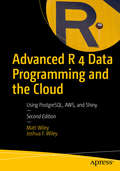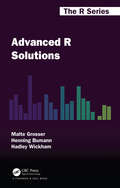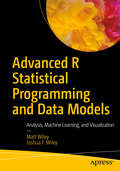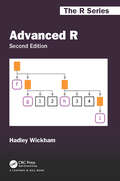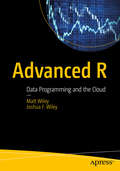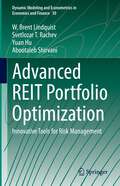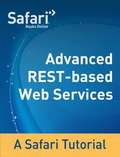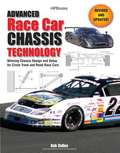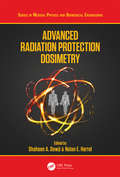- Table View
- List View
Advanced Python Development: Using Powerful Language Features in Real-World Applications
by Matthew WilkesThis book builds on basic Python tutorials to explain various Python language features that aren’t routinely covered: from reusable console scripts that play double duty as micro-services by leveraging entry points, to using asyncio efficiently to collate data from a large number of sources. Along the way, it covers type-hint based linting, low-overhead testing and other automated quality checking to demonstrate a robust real-world development process.Some powerful aspects of Python are often documented with contrived examples that explain the feature as a standalone example only. By following the design and build of a real-world application example from prototype to production quality you'll see not only how the various pieces of functionality work but how they integrate as part of the larger system design process. In addition, you'll benefit from the kind of useful asides and library recommendations that are a staple of conference Q&A sessions at Python conferences as well as discussions of modern Python best practice and techniques to better produce clear code that is easily maintainable.Advanced Python Development is intended for developers who can already write simple programs in Python and want to understand when it’s appropriate to use new and advanced language features and to do so in a confident manner. It is especially of use to developers looking to progress to a more senior level and to very experienced developers who have thus far used older versions of Python.What You'll Learn Understand asynchronous programmingExamine developing plugin architecturesWork with type annotationsReview testing techniquesExplore packaging and dependency managementWho This Book Is ForDevelopers at the mid to senior level who already have Python experience.
Advanced Python Programming: Accelerate your Python programs using proven techniques and design patterns, 2nd Edition
by Quan NguyenWrite fast, robust, and highly reusable applications using Python's internal optimization, state-of-the-art performance-benchmarking tools, and cutting-edge librariesKey FeaturesBenchmark, profile, and accelerate Python programs using optimization toolsScale applications to multiple processors with concurrent programmingMake applications robust and reusable using effective design patternsBook DescriptionPython's powerful capabilities for implementing robust and efficient programs make it one of the most sought-after programming languages.In this book, you'll explore the tools that allow you to improve performance and take your Python programs to the next level.This book starts by examining the built-in as well as external libraries that streamline tasks in the development cycle, such as benchmarking, profiling, and optimizing. You'll then get to grips with using specialized tools such as dedicated libraries and compilers to increase your performance at number-crunching tasks, including training machine learning models.The book covers concurrency, a major solution to making programs more efficient and scalable, and various concurrent programming techniques such as multithreading, multiprocessing, and asynchronous programming.You'll also understand the common problems that cause undesirable behavior in concurrent programs.Finally, you'll work with a wide range of design patterns, including creational, structural, and behavioral patterns that enable you to tackle complex design and architecture challenges, making your programs more robust and maintainable.By the end of the book, you'll be exposed to a wide range of advanced functionalities in Python and be equipped with the practical knowledge needed to apply them to your use cases.What you will learnWrite efficient numerical code with NumPy, pandas, and XarrayUse Cython and Numba to achieve native performanceFind bottlenecks in your Python code using profilersOptimize your machine learning models with JAXImplement multithreaded, multiprocessing, and asynchronous programsSolve common problems in concurrent programming, such as deadlocksTackle architecture challenges with design patternsWho this book is forThis book is for intermediate to experienced Python programmers who are looking to scale up their applications in a systematic and robust manner. Programmers from a range of backgrounds will find this book useful, including software engineers, scientific programmers, and software architects.
Advanced Python Programming: Build high performance, concurrent, and multi-threaded apps with Python using proven design patterns
by Sakis Kasampalis Quan Nguyen Dr. Gabriele LanaroCreate distributed applications with clever design patterns to solve complex problemsKey FeaturesSet up and run distributed algorithms on a cluster using Dask and PySparkMaster skills to accurately implement concurrency in your codeGain practical experience of Python design patterns with real-world examplesBook DescriptionThis Learning Path shows you how to leverage the power of both native and third-party Python libraries for building robust and responsive applications. You will learn about profilers and reactive programming, concurrency and parallelism, as well as tools for making your apps quick and efficient. You will discover how to write code for parallel architectures using TensorFlow and Theano, and use a cluster of computers for large-scale computations using technologies such as Dask and PySpark. With the knowledge of how Python design patterns work, you will be able to clone objects, secure interfaces, dynamically choose algorithms, and accomplish much more in high performance computing.By the end of this Learning Path, you will have the skills and confidence to build engaging models that quickly offer efficient solutions to your problems.This Learning Path includes content from the following Packt products:Python High Performance - Second Edition by Gabriele LanaroMastering Concurrency in Python by Quan NguyenMastering Python Design Patterns by Sakis KasampalisWhat you will learnUse NumPy and pandas to import and manipulate datasetsAchieve native performance with Cython and NumbaWrite asynchronous code using asyncio and RxPyDesign highly scalable programs with application scaffoldingExplore abstract methods to maintain data consistencyClone objects using the prototype patternUse the adapter pattern to make incompatible interfaces compatibleEmploy the strategy pattern to dynamically choose an algorithmWho this book is forThis Learning Path is specially designed for Python developers who want to build high-performance applications and learn about single core and multi-core programming, distributed concurrency, and Python design patterns. Some experience with Python programming language will help you get the most out of this Learning Path.
Advanced Qualitative Research: A Guide to Using Theory
by Nikki Kiyimba Dr Michelle O'ReillyThis distinctive, nuanced book addresses the more complex theoretical issues embedded in the qualitative research paradigm. Adopting a reflective stance that emphasises the role of the researcher it carefully avoids a standardised ‘tick box’ approach to methods. Throughout each chapter, theory is powerfully and persuasively interwoven as its impact on practical topics such as data management and safety in the field is discussed. O'Reilly and Kiyimba bring an authority and clarity to the debate, taking us beyond the mechanical notions of qualitative methods and standardised approaches to research. Instead, they focus on subjects like methodological integrity, perspective driven data collection and theoretically-led analysis. This will be an important resource for anyone looking to practically engage with advanced qualitative research methods.
Advanced Qualitative Research: A Guide to Using Theory
by Nikki Kiyimba Michelle O′ReillyThis distinctive, nuanced book addresses the more complex theoretical issues embedded in the qualitative research paradigm. Adopting a reflective stance that emphasises the role of the researcher it carefully avoids a standardised ‘tick box’ approach to methods. Throughout each chapter, theory is powerfully and persuasively interwoven as its impact on practical topics such as data management and safety in the field is discussed. O′Reilly and Kiyimba bring an authority and clarity to the debate, taking us beyond the mechanical notions of qualitative methods and standardised approaches to research. Instead, they focus on subjects like methodological integrity, perspective driven data collection and theoretically-led analysis. This will be an important resource for anyone looking to practically engage with advanced qualitative research methods.
Advanced Quality Function Deployment
by Fiorenzo FranceschiniA versatile manual that can be used to stimulate product innovation, benchmarking analysis, and engineering design, this book goes beyond theory to provide relevant advanced methods and techniques that readers can apply in their work for both short- and long-term results. The author links Quality Function Deployment (QFD) with other quality design techniques and discusses processes for improving its effectiveness. He also highlights methods for selecting a product's technical features. Real implementation case studies and numerous examples illustrate the concepts, including the Qualitometro method for designing and measuring quality in the service sector.
Advanced Quantitative Finance with C++
by Alonso PenaThe book takes the reader through a fast but structured crash-course in quantitative finance, from theory to practice. If you are a quantitative analyst, risk manager, actuary, or a professional working in the field of quantitative finance and want a quick hands-on introduction to the pricing of financial derivatives, this book is ideal for you. You should be familiar with the basic programming concepts and C++ programming language. You should also be acquainted with calculus of undergraduate level.
Advanced Quantitative Microbiology for Foods and Biosystems: Models for Predicting Growth and Inactivation
by Micha PelegPresenting a novel view of the quantitative modeling of microbial growth and inactivation patterns in food, water, and biosystems, Advanced Quantitative Microbiology for Foods and Biosystems: Models for Predicting Growth and Inactivation describes new models for estimating microbial growth and survival. The author covers traditional and alte
Advanced Quantitative Reasoning: Mathematics for the World Around Us (Texas Edition)
by Gregory D. Foley Thomas R. Butts Stephen W. Phelps Daniel A. ShowalterAdvanced Quantitative Reasoning provides a balanced approach to relevant mathematics for students entering higher education or the workforce. It balances traditional high school mathematics with statistics and modeling; quantitative literacy with financial and overall literacy; and technology-enhanced mathematics with mental and paper-and-pencil mathematics.
Advanced Quantitative Research Methods for Urban Planners
by Reid Ewing Keunhyun ParkAdvanced Quantitative Research Methods for Urban Planners provides fundamental knowledge and hands-on techniques about research, such as research topics and key journals in the planning field, advice for technical writing, and advanced quantitative methodologies. This book aims to provide the reader with a comprehensive and detailed understanding of advanced quantitative methods and to provide guidance on technical writing. Complex material is presented in the simplest and clearest way possible using real-world planning examples and making the theoretical content of each chapter as tangible as possible. Hands-on techniques for a variety of quantitative research studies are covered to provide graduate students, university faculty, and professional researchers with useful guidance and references. A companion to Basic Quantitative Research Methods for Urban Planners, Advanced Quantitative Research Methods for Urban Planners is an ideal read for researchers who want to branch out methodologically and for practicing planners who need to conduct advanced analyses with planning data.
Advanced Quantum Communications
by Sandor Imre Laszlo GyongyosiThe book provides an overview of the most advanced quantum informational geometric techniques, which can help quantum communication theorists analyze quantum channels, such as security or additivity properties. Each section addresses an area of major research of quantum information theory and quantum communication networks. The authors present the fundamental theoretical results of quantum information theory, while also presenting the details of advanced quantum ccommunication protocols with clear mathematical and information theoretical background. This book bridges the gap between quantum physics, quantum information theory, and practical engineering.
Advanced Quantum Condensed Matter Physics: One-Body, Many-Body, and Topological Perspectives
by Michael El-BatanounyCondensed matter physics has fast become the largest discipline within physics. Based on an established course, this comprehensive textbook covers one-body, many-body and topological perspectives. It is the first textbook that presents a comprehensive coverage of topological aspects of condensed matter as a distinct yet integrated component. It covers topological fundamentals and their connection to physics, introduces Berry phase and Chern numbers, describes general topological features of band structures and delineates its classification. Applications as manifest in the quantum Hall effect, topological insulators and Weyl semimetal are presented. Modern topics of current interest are explored in-depth, helping students prepare for cutting-edge research. These include one-electron band theory, path integrals and coherent states functional integrals as well as Green and Matsubara functions, spontaneous symmetry breaking, superfluidity and superconductivity. Multiple chapters covering quantum magnetism are also included. With end-of-chapter exercises throughout, it is ideal for graduate students studying advanced condensed matter physics.
Advanced Quantum Mechanics
by Yuli V. Nazarov Jeroen DanonAn accessible introduction to advanced quantum theory, this graduate-level textbook focuses on its practical applications rather than mathematical technicalities. It treats real-life examples, from topics ranging from quantum transport to nanotechnology, to equip students with a toolbox of theoretical techniques. Beginning with second quantization, the authors illustrate its use with different condensed matter physics examples. They then explain how to quantize classical fields, with a focus on the electromagnetic field, taking students from Maxwell's equations to photons, coherent states and absorption and emission of photons. Following this is a unique master-level presentation on dissipative quantum mechanics, before the textbook concludes with a short introduction to relativistic quantum mechanics, covering the Dirac equation and a relativistic second quantization formalism. The textbook includes 70 end-of-chapter problems. Solutions to some problems are given at the end of the chapter and full solutions to all problems are available for instructors at www. cambridge. org/9780521761505.
Advanced Quantum Mechanics: Materials and Photons (Graduate Texts in Physics)
by Rainer DickAdvanced Quantum Mechanics: Materials and Photons is a textbook which emphasizes the importance of advanced quantum mechanics for materials science and all experimental techniques which employ photon absorption, emission, or scattering. Important aspects of introductory quantum mechanics are covered in the first seven chapters to make the subject self-contained and accessible for a wide audience. The textbook can therefore be used for advanced undergraduate courses and introductory graduate courses which are targeted towards students with diverse academic backgrounds from the Natural Sciences or Engineering. To enhance this inclusive aspect of making the subject as accessible as possible, Appendices A and B also provide introductions to Lagrangian mechanics and the covariant formulation of electrodynamics. Other special features include an introduction to Lagrangian field theory and an integrated discussion of transition amplitudes with discrete or continuous initial or final states. Once students have acquired an understanding of basic quantum mechanics and classical field theory, canonical field quantization is easy. Furthermore, the integrated discussion of transition amplitudes naturally leads to the notions of transition probabilities, decay rates, absorption cross sections and scattering cross sections, which are important for all experimental techniques that use photon probes. Quantization is first discussed for the Schrödinger field before the relativistic Maxwell, Klein-Gordon and Dirac fields are quantized. Quantized Schrödinger field theory is not only important for condensed matter physics and materials science, but also provides the easiest avenue to general field quantization and is therefore also useful for students with an interest in nuclear and particle physics. The quantization of the Maxwell field is performed in Coulomb gauge. This is the appropriate and practically most useful quantization procedure in condensed matter physics, chemistry, and materials science because it naturally separates the effects of Coulomb interactions, exchange interactions, and photon scattering. The appendices contain additional material that is usually not found in standard quantum mechanics textbooks, including a completeness proof of eigenfunctions of one-dimensional Sturm-Liouville problems, logarithms of matrices, and Green's functions in different dimensions.
Advanced Quantum Mechanics: Materials and Photons (Graduate Texts in Physics)
by Rainer DickThis textbook, now in an expanded third edition, emphasizes the importance of advanced quantum mechanics for materials science and all experimental techniques which employ photon absorption, emission, or scattering. Important aspects of introductory quantum mechanics are covered in the first seven chapters to make the subject self-contained and accessible for a wide audience. Advanced Quantum Mechanics: Materials and Photons can therefore be used for advanced undergraduate courses and introductory graduate courses which are targeted towards students with diverse academic backgrounds from the Natural Sciences or Engineering. To enhance this inclusive aspect of making the subject as accessible as possible, introductions to Lagrangian mechanics and the covariant formulation of electrodynamics are provided in appendices. This third edition includes 60 new exercises, new and improved illustrations, and new material on interpretations of quantum mechanics. Other special features include an introduction to Lagrangian field theory and an integrated discussion of transition amplitudes with discrete or continuous initial or final states. Once students have acquired an understanding of basic quantum mechanics and classical field theory, canonical field quantization is easy. Furthermore, the integrated discussion of transition amplitudes naturally leads to the notions of transition probabilities, decay rates, absorption cross sections and scattering cross sections, which are important for all experimental techniques that use photon probes.
Advanced R 4 Data Programming and the Cloud: Using PostgreSQL, AWS, and Shiny
by Joshua F. Wiley Matt WileyProgram for data analysis using R and learn practical skills to make your work more efficient. This revised book explores how to automate running code and the creation of reports to share your results, as well as writing functions and packages. It includes key R 4 features such as a new color palette for charts, an enhanced reference counting system, and normalization of matrix and array types where matrix objects now formally inherit from the array class, eliminating inconsistencies.Advanced R 4 Data Programming and the Cloud is not designed to teach advanced R programming nor to teach the theory behind statistical procedures. Rather, it is designed to be a practical guide moving beyond merely using R; it shows you how to program in R to automate tasks. This book will teach you how to manipulate data in modern R structures and includes connecting R to databases such as PostgreSQL, cloud services such as Amazon Web Services (AWS), and digital dashboards such as Shiny. Each chapter also includes a detailed bibliography with references to research articles and other resources that cover relevant conceptual and theoretical topics.What You Will Learn Write and document R functions using R 4Make an R package and share it via GitHub or privatelyAdd tests to R code to ensure it works as intendedUse R to talk directly to databases and do complex data managementRun R in the Amazon cloudDeploy a Shiny digital dashboardGenerate presentation-ready tables and reports using RWho This Book Is ForWorking professionals, researchers, and students who are familiar with R and basic statistical techniques such as linear regression and who want to learn how to take their R coding and programming to the next level.
Advanced R Solutions (Chapman & Hall/CRC The R Series)
by Hadley Wickham Malte Grosser Henning BumannThis book offers solutions to all 284 exercises in Advanced R, Second Edition. All the solutions have been carefully documented and made to be as clear and accessible as possible. Working through the exercises and their solutions will give you a deeper understanding of a variety of programming challenges, many of which are relevant to everyday work. This will expand your set of tools on a technical and conceptual level. You will be able to transfer many of the specific programming schemes directly and will discover far more elegant solutions to everyday problems. Features: When R creates copies, and how it affects memory usage and code performance Everything you could ever want to know about functions The differences between calling and exiting handlers How to employ functional programming to solve modular tasks The motivation, mechanics, usage, and limitations of R's highly pragmatic S3 OO system The R6 OO system, which is more like OO programming in other languages The rules that R uses to parse and evaluate expressions How to use metaprogramming to generate HTML or LaTeX with elegant R code How to identify and resolve performance bottlenecks
Advanced R Statistical Programming and Data Models
by Joshua F. Wiley Matt WileyCarry out a variety of advanced statistical analyses including generalized additive models, mixed effects models, multiple imputation, machine learning, and missing data techniques using R. Each chapter starts with conceptual background information about the techniques, includes multiple examples using R to achieve results, and concludes with a case study. <P><P> Written by Matt and Joshua F. Wiley, Advanced R Statistical Programming and Data Models shows you how to conduct data analysis using the popular R language. You’ll delve into the preconditions or hypothesis for various statistical tests and techniques and work through concrete examples using R for a variety of these next-level analytics. This is a must-have guide and reference on using and programming with the R language.
Advanced R, Second Edition (Chapman & Hall/CRC The R Series)
by Hadley WickhamAdvanced R presents useful tools and techniques for attacking many types of R programming problems, helping you avoid mistakes and dead ends. With more than ten years of experience programming in R, the author illustrates the elegance, beauty, and flexibility at the heart of R. The book develops the necessary skills to produce quality code that can be used in a variety of circumstances. You will learn: The fundamentals of R, including standard data types and functions Functional programming as a useful framework for solving wide classes of problems The positives and negatives of metaprogramming How to write fast, memory-efficient code
Advanced R: Data Programming and the Cloud
by Joshua F. Wiley Matt WileyProgram for data analysis using R and learn practical skills to make your work more efficient. This book covers how to automate running code and the creation of reports to share your results, as well as writing functions and packages. Advanced R is not designed to teach advanced R programming nor to teach the theory behind statistical procedures. Rather, it is designed to be a practical guide moving beyond merely using R to programming in R to automate tasks. This book will show you how to manipulate data in modern R structures and includes connecting R to data bases such as SQLite, PostgeSQL, and MongoDB. The book closes with a hands-on section to get R running in the cloud. Each chapter also includes a detailed bibliography with references to research articles and other resources that cover relevant conceptual and theoretical topics. What You Will Learn Write and document R functions Make an R package and share it via GitHub or privately Add tests to R code to insure it works as intended Build packages automatically with GitHub Use R to talk directly to databases and do complex data management Run R in the Amazon cloud Generate presentation-ready tables and reports using R Who This Book Is For Working professionals, researchers, or students who are familiar with R and basic statistical techniques such as linear regression and who want to learn how to take their R coding and programming to the next level.
Advanced REIT Portfolio Optimization: Innovative Tools for Risk Management (Dynamic Modeling and Econometrics in Economics and Finance #30)
by Svetlozar T. Rachev Yuan Hu W. Brent Lindquist Abootaleb ShirvaniThis book provides an investor-friendly presentation of the premises and applications of the quantitative finance models governing investment in one asset class of publicly traded stocks, specifically real estate investment trusts (REITs). The models provide highly advanced analytics for REIT investment, including: portfolio optimization using both historic and predictive return estimation; model backtesting; a complete spectrum of risk assessment and management tools with an emphasis on early warning systems, risk budgeting, estimating tail risk, and factor analysis; derivative valuation; and incorporating ESG ratings into REIT investment. These quantitative finance models are presented in a unified framework consistent with dynamic asset pricing (rational finance). Given its scope and practical orientation, this book will appeal to investors interested in portfolio optimization and innovative tools for investment risk assessment.
Advanced RESTful Web Services: A Safari Tutorial
by Safari Content TeamThis is the last of a three-part series looking at how to build RESTful web services. The series covers all aspects of REST services, from basic HTTP-level interactions, through to matching these operations in your existing code and applications, network security, and adherence for REST standards. With advanced REST deployments, the key considerations are the methods required to build, deploy, and place your REST solution into production. Key to this should be understanding how best to implement your web services and RESTful architecture to take advantage of the SOA environment and your existing enterprise infrastructure. Deployment requires testing and installation within the distributed environment of your typical SOA deployment. Follow along in this tutorial to learn about all of these advanced RESTful skills in Safari Books Online.
Advanced Race Car Chassis Technology HP1562
by Bob BollesUpdated with nearly 60 percent new material on the latest racing technology, this book details how to design, build, and setup the chassis and suspension for road race and stock cars. Includes chassis dynamics, spring and shock theory, front and rear suspension geometry, real world racing aerodynamics, steering systems, racing chassis software and all you need to know to set you chassis up to win races.
Advanced Radiation Detector and Instrumentation in Nuclear and Particle Physics: Proceedings of RAPID 2021 (Springer Proceedings in Physics #282)
by Rajendra Nath PatraThe RAPID2021 workshop focused on a specific and contemporary research topic: detector technology and electronics for nuclear and particle physics experiments as well as applications. In the RAPID2021, we had invited lectures, overview talks and contributed presentations by the scientists and young researchers from all around the world. In this workshop the papers presented are on the new developments at different experiments (ALICE, CMS, ATLAS) at CERN, new micro-pattern gas detectors development by RD51 collaboration at CERN, development of silicon pixel sensors at CERN, detectors for FAIR facilities in Germany, low energy experiments at different facilities, new detector ideas for nuclear and particle physics experiments, developments in electronics to overcome the challenges for the future LHC experiments, and application of the detectors on medical imaging. The proceedings of the workshop are quite helpful to document the new results, technologies, and developments by different groups and well known international laboratories like CERN, GSI, and Brookhaven National Laboratory. The publication of the scientists and young researchers will definitely be the new references for future studies on the same direction.
Advanced Radiation Protection Dosimetry (Series in Medical Physics and Biomedical Engineering)
by Shaheen Dewji Nolan E. HertelAlthough many radiation protection scientists and engineers use dose coefficients, few know the origin of those dose coefficients. This is the first book in over 40 years to address the topic of radiation protection dosimetry in intimate detail. Advanced Radiation Protection Dosimetry covers all methods used in radiation protection dosimetry, including advanced external and internal radiation dosimetry concepts and regulatory applications. This book is an ideal reference for both scientists and practitioners in radiation protection and students in graduate health physics and medical physics courses. Features: A much-needed book filling a gap in the market in a rapidly expanding area Contains the history, evolution, and the most up-to-date computational dosimetry models Authored and edited by internationally recognized authorities and subject area specialists Interrogates both the origins and methodologies of dose coefficient calculation Incorporates the latest international guidance for radiation dosimetry and protection
